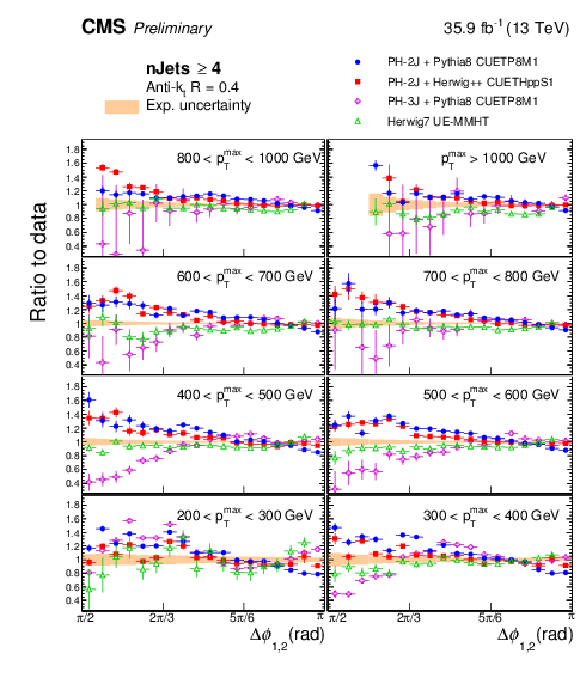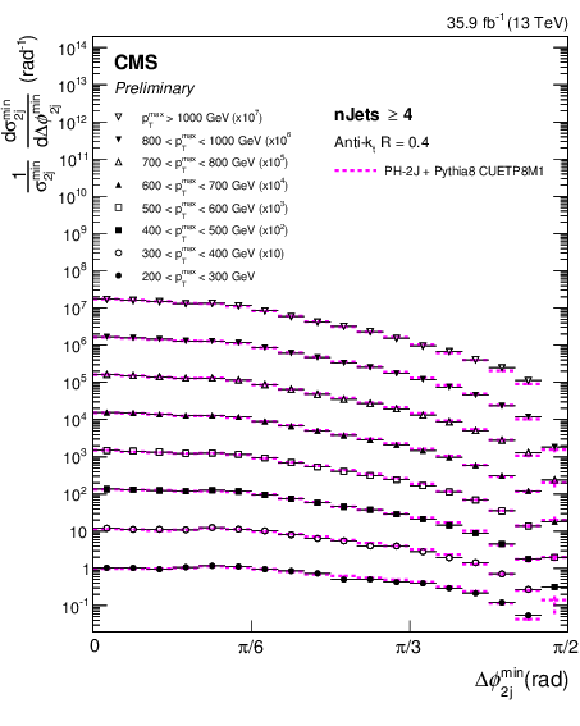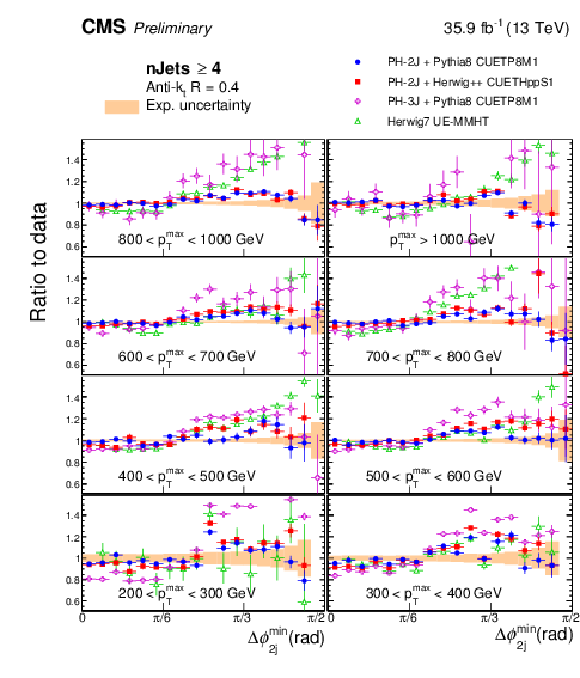

Compact Muon Solenoid
LHC, CERN
| CMS-PAS-SMP-16-014 | ||
| Measurements of inclusive 2-jet, 3-jet and 4-jet azimuthal correlations in pp collisions at $\sqrt{s}= $ 13 TeV | ||
| CMS Collaboration | ||
| March 2017 | ||
| Abstract: Measurements of the correlation of azimuthal angles between the two jets with the largest transverse momenta ($p_\mathrm{T}$) in inclusive 2-jet, 3-jet, and 4-jet topologies are presented for several regions of the leading jet transverse momentum up to 4 TeV. For the case of 3-jet and 4-jet topologies measurements of the correlation of minimum azimuthal angles between any two of the three or four leading $p_\mathrm{T}$ jets are also presented. The analysis is based on the proton-proton collision data collected with the CMS experiment at a centre-of-mass energy of 13 TeV corresponding to an integrated luminosity of 35.9 fb$^{-1}$. The results are generally well reproduced by predictions using Monte Carlo event generators which combine perturbative QCD calculations up to next-to-leading-order accuracy with contributions from parton showers, hadronization, and multiparton interactions. The features of the different models considered in the comparisons and their performance on describing the measurement are discussed. | ||
|
Links:
CDS record (PDF) ;
inSPIRE record ;
CADI line (restricted) ;
These preliminary results are superseded in this paper, EPJC 78 (2018) 566. The superseded preliminary plots can be found here. |
||
| Figures & Tables | Summary | Additional Figures | References | CMS Publications |
|---|
| Figures | |

png pdf |
Figure 1:
Normalized inclusive 2-jet cross section differential in $ {\Delta \phi _\text {1,2}} $ for nine $ { {p_{\mathrm {T}}} ^{\text {max}}} $ regions, scaled by multiplicative factors for presentation purposes. The error bars on the data points include statistical and systematic uncertainties. Overlaid on the data are predictions from the ph-2j+pythia8 event generator. |

png pdf |
Figure 2:
Ratios of pythia8 , herwig++ , and MadGraph+pythia8 predictions to the normalized inclusive 2-jet cross section differential in $ {\Delta \phi _\text {1,2}} $ , for all $ { {p_{\mathrm {T}}} ^{\text {max}}} $ regions. The solid band indicates the total experimental uncertainty and the error bars on the MC points represent the statistical uncertainties of the simulated data. |

png pdf |
Figure 3:
Ratios of ph-2j+pythia8 , ph-2j+herwig++ , ph-3j+pythia8 , and herwig7 predictions to the normalized inclusive 2-jet cross section differential in $ {\Delta \phi _\text {1,2}} $ , for all $ { {p_{\mathrm {T}}} ^{\text {max}}} $ regions. The solid band indicates the total experimental uncertainty and the error bars on the MC points represent the statistical uncertainties of the simulated data. |

png pdf |
Figure 4:
Normalized inclusive 3-jet cross section differential in $ {\Delta \phi _\text {1,2}} $ for eight $ { {p_{\mathrm {T}}} ^{\text {max}}} $ regions, scaled by multiplicative factors for presentation purposes. The error bars on the data points include statistical and systematic uncertainties. Overlaid on the data are predictions from the ph-2j+pythia8 event generator. |

png pdf |
Figure 5:
Ratios of pythia8 , herwig++ , and MadGraph+pythia8 predictions to the normalized inclusive 3-jet cross section differential in $ {\Delta \phi _\text {1,2}} $ , for all $ { {p_{\mathrm {T}}} ^{\text {max}}} $ regions. The solid band indicates the total experimental uncertainty and the error bars on the MC points represent the statistical uncertainties of the simulated data. |

png pdf |
Figure 6:
Ratios of ph-2j+pythia8 , ph-2j+herwig++ , ph-3j+pythia8 , and herwig7 predictions to the normalized inclusive 3-jet cross section differential in $ {\Delta \phi _\text {1,2}} $ , for all $ { {p_{\mathrm {T}}} ^{\text {max}}} $ regions. The solid band indicates the total experimental uncertainty and the error bars on the MC points represent the statistical uncertainties of the simulated data. |

png pdf |
Figure 7:
Normalized inclusive 4-jet cross section differential in $ {\Delta \phi _\text {1,2}} $ for eight $ { {p_{\mathrm {T}}} ^{\text {max}}} $ regions, scaled by multiplicative factors for presentation purposes. The error bars on the data points include statistical and systematic uncertainties. Overlaid on the data are predictions from the ph-2j+pythia8 event generator. |

png pdf |
Figure 8:
Ratios of pythia8 , herwig++ , and MadGraph+pythia8 predictions to the normalized inclusive 4-jet cross section differential in $ {\Delta \phi _\text {1,2}} $ , for all $ { {p_{\mathrm {T}}} ^{\text {max}}} $ regions. The solid band indicates the total experimental uncertainty and the error bars on the MC points represent the statistical uncertainties of the simulated data. |

png pdf |
Figure 9:
Ratios of ph-2j+pythia8 , ph-2j+herwig++ , ph-3j+pythia8 , and herwig7 predictions to the normalized inclusive 4-jet cross section differential in $ {\Delta \phi _\text {1,2}} $ , for all $ { {p_{\mathrm {T}}} ^{\text {max}}} $ regions. The solid band indicates the total experimental uncertainty and the error bars on the MC points represent the statistical uncertainties of the simulated data. |

png pdf |
Figure 10:
Normalized inclusive 3-jet cross section differential in $ {\Delta \phi _\text {2j}^\text {min}} $ for eight $ { {p_{\mathrm {T}}} ^{\text {max}}} $ regions, scaled by multiplicative factors for presentation purposes. The error bars on the data points include statistical and systematic uncertainties. Overlaid on the data are predictions from the ph-2j+pythia8 event generator. |

png pdf |
Figure 11:
Ratios of pythia8 , herwig++ , and MadGraph+pythia8 predictions to the normalized inclusive 3-jet cross section differential in $ {\Delta \phi _\text {2j}^\text {min}} $ , for all $ { {p_{\mathrm {T}}} ^{\text {max}}} $ regions. The solid band indicates the total experimental uncertainty and the error bars on the MC points represent the statistical uncertainties of the simulated data. |

png pdf |
Figure 12:
Ratios of ph-2j+pythia8 , ph-2j+herwig++ , ph-3j+pythia8 , and herwig7 predictions to the normalized inclusive 3-jet cross section differential in $ {\Delta \phi _\text {2j}^\text {min}} $ , for all $ { {p_{\mathrm {T}}} ^{\text {max}}} $ regions. The solid band indicates the total experimental uncertainty and the error bars on the MC points represent the statistical uncertainties of the simulated data. |

png pdf |
Figure 13:
Normalized inclusive 4-jet cross section differential in $ {\Delta \phi _\text {2j}^\text {min}} $ for eight $ { {p_{\mathrm {T}}} ^{\text {max}}} $ regions, scaled by multiplicative factors for presentation purposes. The error bars on the data points include statistical and systematic uncertainties. Overlaid on the data are predictions from the ph-2j+pythia8 event generator. |

png pdf |
Figure 14:
Ratios of pythia8 , herwig++ , and MadGraph+pythia8 predictions to the normalized inclusive 4-jet cross section differential in $ {\Delta \phi _\text {2j}^\text {min}} $ , for all $ { {p_{\mathrm {T}}} ^{\text {max}}} $ regions. The solid band indicates the total experimental uncertainty and the error bars on the MC points represent the statistical uncertainties of the simulated data. |

png pdf |
Figure 15:
Ratios of ph-2j+pythia8 , ph-2j+herwig++ , ph-3j+pythia8 , and herwig7 predictions to the normalized inclusive 4-jet cross section differential in $ {\Delta \phi _\text {2j}^\text {min}} $ , for all $ { {p_{\mathrm {T}}} ^{\text {max}}} $ regions. The solid band indicates the total experimental uncertainty and the error bars on the MC points represent the statistical uncertainties of the simulated data. |
| Tables | |

png pdf |
Table 1:
The integrated luminosity for each trigger sample considered in this analysis. |

png pdf |
Table 2:
Monte Carlo event generators used for comparison in this analysis. Version of the generators, PDF set, underlying event tune, and corresponding references are listed. |
| Summary |
|
Measurements of the normalized inclusive 2-jet, 3-jet, and 4-jet cross sections differential in $ {\Delta \phi _\text {1,2}} $ and of the normalized inclusive 3-jet, and 4-jet cross sections differential in $ {\Delta \phi _\text {2j}^\text {min}} $, are presented for several regions in the leading-jet transverse momentum $ p_{\mathrm{T}}^{\text{max}} $. The measurements are performed using data collected during 2016 with the CMS experiment at the CERN LHC, corresponding to an integrated luminosity of 35.9 fb$^{-1}$ of proton-proton collisions at $ \sqrt{s} = $ 13 TeV. The measured distributions in $ {\Delta \phi _\text {1,2}} $ and $ {\Delta \phi _\text {2j}^\text {min}} $ are compared to predictions from PYTHIAE, HERWIGpp, MadGraph + PYTHIAE, POWHEGTWOJET matched to PYTHIAE and HERWIGpp, POWHEGTHREEJET + PYTHIAE, and HERWIGSEVEN event generators. The LO PYTHIAE dijet event generator exhibits small deviations from the $ {\Delta \phi _\text {1,2}} $ measurements, and fails to describe the $ {\Delta \phi _\text {2j}^\text {min}} $ distributions. The HERWIGpp event generator exhibits the largest deviations from the $ {\Delta \phi _\text {1,2}} $ measurements but provides a reasonable description of the $ {\Delta \phi _\text {2j}^\text {min}} $ distributions. The tree-level multijet event generator MadGraph in combination with PYTHIAE for showering, hadronization, and multiparton interactions provides a good overall description of the measurements except for the $ {\Delta \phi _\text {2j}^\text {min}} $ distributions in the 4-jet case where the generator seems to reach its limit. The dijet NLO POWHEGTWOJET event generator exhibits deviations from the $ {\Delta \phi _\text {1,2}} $ measurements, but provides a good description of the $ {\Delta \phi _\text {2j}^\text {min}} $ observable. The three jet NLO POWHEGTHREEJET event generator exhibits large deviations from the measurements and describe the considered multijet observables in a less accurate way than the predictions generated by POWHEGTWOJET. Parton-shower contributions are responsible for the different behaviour of the POWHEGTWOJET and POWHEGTHREEJET predictions. Finally, predictions from the dijet NLO HERWIGSEVEN event generator provide a very good description of the $ {\Delta \phi _\text {1,2}} $ measurements, showing a very large improvement in comparison to HERWIGpp. All these observations emphasize the need to improve predictions for multijet production. Similar observations, for the inclusive 2-jet cross sections differential in $ {\Delta \phi _\text {1,2}} $, were reported previously by CMS [5] at a different center-of-mass energy. The extension of $ {\Delta \phi _\text {1,2}} $ correlations, and the measurement of the $ {\Delta \phi _\text {2j}^\text {min}} $ distributions in inclusive 3-jet and 4-jet topologies are new results of the present analysis. |
| Additional Figures | |

png pdf |
Additional Figure 1:
A three jets event display. Leading jet $ {p_{\mathrm {T}}} =$ 709.026 GeV, $y=-0.396$, $\phi = 1.544 $ rad. Second jet $ {p_{\mathrm {T}}} =$ 708.860 GeV, $y= 0.343$, $\phi =-2.655 $ rad. Third jet $ {p_{\mathrm {T}}} =$ 702.888 GeV, $y= 0.304$, $\phi =-0.561 $ rad. |

png pdf |
Additional Figure 2:
A four jets event display. Leading jet $ {p_{\mathrm {T}}} = $ 234.481 GeV, $y=-0.714$, $\phi =-2.820 $ rad. Second jet $ {p_{\mathrm {T}}} =$ 223.978 GeV, $y= 1.477$, $\phi = 0.349 $ rad. Third jet $ {p_{\mathrm {T}}} =$ 216.236 GeV, $y= 0.375$, $\phi = 1.977 $ rad. Fourth jet $ {p_{\mathrm {T}}} =$ 195.639 GeV, $y=-0.823$, $\phi =-1.199 $ rad. |
| References | ||||
| 1 | D0 Collaboration | Measurement of dijet azimuthal decorrelations at central rapidities in $ \mathrm{p}\overline{\mathrm{p}} $ collisions at $ \sqrt{s}= $ 1.96 TeV | PRL 94 (2005) 221801 | hep-ex/0409040 |
| 2 | D0 Collaboration | Measurement of the combined rapidity and $ p_{T} $ dependence of dijet azimuthal decorrelations in $ \mathrm{p}\overline{\mathrm{p}} $ collisions at $ \sqrt{s}= $ 1.96 TeV | PLB 721 (2013) 212 | 1212.1842 |
| 3 | ATLAS Collaboration | Measurement of dijet azimuthal decorrelations in $ \mathrm{p}\mathrm{p} $ collisions at $ \sqrt{s}= $ 7 TeV | PRL 106 (2011) 172002 | 1102.2696 |
| 4 | CMS Collaboration | Dijet azimuthal decorrelations in $ \mathrm{p}\mathrm{p} $ collisions at $ \sqrt{s}= $ 7 TeV | PRL 106 (2011) 122003 | CMS-QCD-10-026 1101.5029 |
| 5 | CMS Collaboration | Measurement of dijet azimuthal decorrelation in pp collisions at $ \sqrt{s}= $ 8 TeV | EPJC 76 (2016) 536 | CMS-SMP-14-015 1602.04384 |
| 6 | ATLAS Collaboration | Measurement of three-jet production cross-sections in $ pp $ collisions at 7 TeV centre-of-mass energy using the ATLAS detector | EPJC 75 (2015) 228 | 1411.1855 |
| 7 | ATLAS Collaboration | Measurement of four-jet differential cross sections in $ \sqrt{s}= $ 8 TeV proton-proton collisions using the ATLAS detector | JHEP 12 (2015) 105 | 1509.07335 |
| 8 | CMS Collaboration | The CMS experiment at the CERN LHC | JINST 03 (2008) S08004 | CMS-00-001 |
| 9 | CMS Collaboration | The CMS high level trigger | EPJC 46 (2006) 605 | hep-ex/0512077 |
| 10 | CMS Collaboration | Particle--flow event reconstruction in CMS and performance for jets, taus, and $ E_{\mathrm{T}}^{\text{miss}} $ | CDS | |
| 11 | CMS Collaboration | Commissioning of the Particle--flow Event Reconstruction with the first LHC collisions recorded in the CMS detector | CDS | |
| 12 | M. Cacciari, G. P. Salam, and G. Soyez | The anti-$ k_{\mathrm{t}} $ jet clustering algorithm | JHEP 04 (2008) 063 | 0802.1189 |
| 13 | M. Cacciari, G. P. Salam, and G. Soyez | FastJet user manual | EPJC 72 (2012) 1896 | 1111.6097 |
| 14 | CMS Collaboration | Jet energy scale and resolution in the CMS experiment in pp collisions at 8 TeV | CMS-JME-13-004 1607.03663 |
|
| 15 | T. Sjostrand et al. | An introduction to PYTHIA 8.2 | CPC 191 (2015) 159 | 1410.3012 |
| 16 | CMS Collaboration | Event generator tunes obtained from underlying event and multiparton scattering measurements | EPJC 76 (2016) 1 | CMS-GEN-14-001 1512.00815 |
| 17 | GEANT4 Collaboration | Geant4 -- a simulation tool kit | NIMA 506 (2003) 250 | |
| 18 | CMS Collaboration | Description and performance of track and primary-vertex reconstruction with the CMS tracker | JINST 09 (2014) P10009 | CMS-TRK-11-001 1405.6569 |
| 19 | CMS Collaboration | Jet performance in pp collisions at $ \sqrt{s}= $ 7 TeV | CDS | |
| 20 | T. Adye | Unfolding algorithms and tests using RooUnfold | 1105.1160 | |
| 21 | M. Bahr et al. | Herwig++ physics and manual | EPJC 58 (2008) 639 | 0803.0883 |
| 22 | B. Andersson | The Lund model | Camb. Monogr. Part. Phys. Nucl. Phys. Cosmol. 7 (1997) 1 | |
| 23 | B. R. Webber | A QCD model for jet fragmentation including soft gluon interference | Nucl. Phys. B 238 (1984) 492 | |
| 24 | R. Corke and T. Sjostrand | Interleaved parton showers and tuning prospects | JHEP 03 (2011) 032 | 1011.1759 |
| 25 | CMS Collaboration | Event generator tunes obtained from underlying event and multiparton scattering measurements | EPJC 76 (2016) 155 | CMS-GEN-14-001 1512.00815 |
| 26 | NNPDF Collaboration | Parton distributions with QED corrections | Nucl. Phys. B 877 (2013) 290 | 1308.0598 |
| 27 | NNPDF Collaboration | Unbiased global determination of parton distributions and their uncertainties at NNLO and at LO | Nucl. Phys. B 855 (2012) 153 | 1107.2652 |
| 28 | J. Pumplin et al. | New generation of parton distributions with uncertainties from global QCD analysis | JHEP 07 (2002) 012 | hep-ph/0201195 |
| 29 | J. Alwall et al. | MadGraph 5: going beyond | JHEP 06 (2011) 128 | 1106.0522 |
| 30 | S. Mrenna and P. Richardson | Matching matrix elements and parton showers with HERWIG and PYTHIA | JHEP 05 (2004) 040 | hep-ph/0312274 |
| 31 | S. Frixione, P. Nason, and C. Oleari | Matching NLO QCD computations with parton shower simulations: the POWHEG method | JHEP 11 (2007) 070 | 0709.2092 |
| 32 | S. Alioli, P. Nason, C. Oleari, and E. Re | A general framework for implementing NLO calculations in shower Monte Carlo programs: the POWHEG BOX | JHEP 06 (2010) 043 | 1002.2581 |
| 33 | P. Nason | A new method for combining NLO QCD with shower Monte Carlo algorithms | JHEP 11 (2004) 040 | hep-ph/0409146 |
| 34 | J. Bellm et al. | Herwig 7.0/Herwig++ 3.0 release note | EPJC 76 (2016) 196 | 1512.01178 |
| 35 | S. Alioli et al. | Jet pair production in POWHEG | JHEP 11 (2011) 081 | 1012.3380 |
| 36 | A. Kardos, P. Nason, and C. Oleari | Three-jet production in POWHEG | JHEP 04 (2014) 043 | 1402.4001 |
| 37 | NNPDF Collaboration | Parton distributions for the LHC Run II | JHEP 04 (2015) 040 | 1410.8849 |
| 38 | L. A. Harland-Lang, A. D. Martin, P. Motylinski, and R. S. Thorne | Parton distributions in the LHC era: MMHT 2014 PDFs | EPJC 75 (2015) 204 | 1412.3989 |
| 39 | R. Frederix and S. Frixione | Merging meets matching in MC@NLO | JHEP 12 (2012) 061 | 1209.6215 |
| 40 | S. Frixione and B. R. Webber | Matching NLO QCD computations and parton shower simulations | JHEP 06 (2002) 029 | hep-ph/0204244 |
| 41 | S. Platzer | private communication | ||

|
Compact Muon Solenoid LHC, CERN |

|

|

|

|

|

|